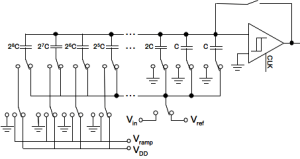A SAR ADC with Adiabatic Charging for Use in Medical Implants
The proposed research program has two primary goals. The first goal is to improve the evaluation and treatment of patients with diabetes and a variety of movement disorders including Parkinson’s disease, restless leg syndrome, and essential tremor, by allowing doctors to continuously monitor relevant biomarkers over much longer time scales and with better precision than currently possible. The second goal is that the proposed implant be a platform for electronic sensory monitoring that is inexpensive and flexible and that can be used with a wide variety of sensors and for a wide variety of purposes, such as chemical sensors for monitoring blood chemistry. In this work, we develop an energy-efficient analog-to-digital converter designed to operate with a power management scheme using ultracapacitors as opposed to a battery.
Two techniques are employed to save on energy for the entire system. The first is to use adiabatic charging [1] [2] of the capacitors contained in the SAR ADC. This application is ideal for adiabatic techniques because of the low frequency of operation and the ease at which we can reclaim energy from discharging the capacitors. Figures 1 and 2 show the necessary circuits for implementing the adiabatic charging. The second technique is to employ compressive sampling (CS) [3] [4] to sample slower than the Nyquist rate. Leveraging the fact that tremor data is sparse in the frequency domain, we can implement the CS technique before the ADC to save energy and decrease the size of the memory. In our application, both of energy and size are important bottlenecks because the ADC is the dominant power consumer, and memory size is a significant factor for long-term data storage.
References
- L.J. Svensson and J.G. Koller, “Driving a capacitive load without dissipating fCV2,” in IEEE Symposium on Low Power Electronics, pp. 100-101, Oct. 1994. [↩]
- J.G Koller and L.J. Svensson, “Adiabatic charging without inductors,” USC/ISI technical report ACMOSTR-3a, Feb. 8, 1994. [↩]
- E. Candes, “Compressive sampling,” Int. Congress of Mathematics, 3, pp. 1433-1452, Madrid, Spain, 2006. [↩]
- P. Bofounos, J. Romberg, and R. Baraniuk, “Compressive sensing – theory and applications,” in IEEE Int. Conf on Acoustics, Speech, and Signal Processing (ICASSP), Las Vegas, Nevada, Apr. 2008. [↩]

